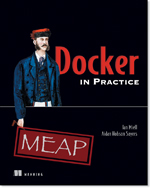Currently co-authoring a book on Docker: Get 39% off with the code 39miell
TL;DR
These commands can tell you what key bindings you have in your bash shell by default.
bind -P | grep 'can be' stty -a | grep ' = ..;'
Background
I’d aways wondered what key strokes did what in bash – I’d picked up some well-known ones (CTRL-r, CTRL-v, CTRL-d etc) from bugging people when I saw them being used, but always wondered whether there was a list of these I could easily get and comprehend. I found some, but always forgot where it was when I needed them, and couldn’t remember many of them anyway.
Then debugging a problem tab completion in ‘here’ documents, I stumbled across bind.
bind and stty
‘bind’ is a bash builtin, which means it’s not a program like awk or grep, but is picked up and handled by the bash program itself.
It manages the various key bindings in the bash shell, covering everything from autocomplete to transposing two characters on the command line. You can read all about it in the bash man page (in the builtins section, near the end).
Bind is not responsible for all the key bindings in your shell – running the stty will show the ones that apply to the terminal:
stty -a | grep ' = ..;'
These take precedence and can be confusing if you’ve tried to bind the same thing in your shell! Further confusion is caused by the fact that ‘^D’ means ‘CTRL and d pressed together whereas in bind output, it would be ‘C-d’.
edit: am indebted to joepvd from hackernews for this beauty
$ stty -a | awk 'BEGIN{RS="[;n]+ ?"}; /= ..$/'
intr = ^C
quit = ^
erase = ^?
kill = ^U
eof = ^D
swtch = ^Z
susp = ^Z
rprnt = ^R
werase = ^W
lnext = ^V
flush = ^O
Breaking Down the Command
bind -P | grep can
Can be considered (almost) equivalent to a more instructive command:
bind -l | sed 's/.*/bind -q /' | /bin/bash 2>&1 | grep -v warning: | grep can
‘bind -l’ lists all the available keystroke functions. For example, ‘complete’ is the auto-complete function normally triggered by hitting ‘tab’ twice. The output of this is passed to a sed command which passes each function name to ‘bind -q’, which queries the bindings.
sed 's/.*/bind -q /'
The output of this is passed for running into /bin/bash.
/bin/bash 2>&1 | grep -v warning: | grep 'can be'
Note that this invocation of bash means that locally-set bindings will revert to the default bash ones for the output.
The ‘2>&1’ puts the error output (the warnings) to the same output channel, filtering out warnings with a ‘grep -v’ and then filtering on output that describes how to trigger the function.
In the output of bind -q, ‘C-‘ means ‘the ctrl key and’. So ‘C-c’ is the normal. Similarly, ‘t’ means ‘escape’, so ‘tt’ means ‘autocomplete’, and ‘e’ means escape:
$ bind -q complete complete can be invoked via "C-i", "ee".
and is also bound to ‘C-i’ (though on my machine I appear to need to press it twice – not sure why).
Add to bashrc
I added this alias as ‘binds’ in my bashrc so I could easily get hold of this list in the future.
alias binds="bind -P | grep 'can be'"
Now whenever I forget a binding, I type ‘binds’, and have a read :)
[adinserter block=”1″]
The Zinger
Browsing through the bash manual, I noticed that an option to bind enables binding to
-x keyseq:shell-command
So now all I need to remember is one shortcut to get my list (CTRL-x, then CTRL-o):
bind -x '"C-xC-o":bind -P | grep can'
Of course, you can bind to a single key if you want, and any command you want. You could also use this for practical jokes on your colleagues…
Now I’m going to sort through my history to see what I type most often :)
This post is based on material from Docker in Practice, available on Manning’s Early Access Program. Get 39% off with the code: 39miell


Typo:
bind -l | sed ‘s/.*/bind -q /’ | /bin/bash 2>&1 | grep -v warning: | grep can
It looks like the sed command lost a character or two. :-)